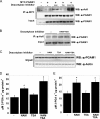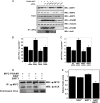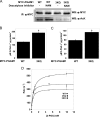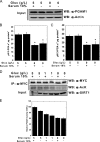Regulation of glycolytic enzyme phosphoglycerate mutase-1 by Sirt1 protein-mediated deacetylation
- PMID: 22157007
- PMCID: PMC3281715
- DOI: 10.1074/jbc.M111.317404
Regulation of glycolytic enzyme phosphoglycerate mutase-1 by Sirt1 protein-mediated deacetylation
Abstract
Emerging proteomic evidence suggests that acetylation of metabolic enzymes is a prevalent post-translational modification. In a few recent reports, acetylation down-regulated activity of specific enzymes in fatty acid oxidation, urea cycle, electron transport, and anti-oxidant pathways. Here, we reveal that the glycolytic enzyme phosphoglycerate mutase-1 (PGAM1) is negatively regulated by Sirt1, a member of the NAD(+)-dependent protein deacetylases. Acetylated PGAM1 displays enhanced activity, although Sirt1-mediated deacetylation reduces activity. Acetylation sites mapped to the C-terminal "cap," a region previously known to affect catalytic efficiency. Overexpression of a constitutively active variant (acetylated mimic) of PGAM1 stimulated flux through glycolysis. Under glucose restriction, Sirt1 levels dramatically increased, leading to PGAM1 deacetylation and attenuated activity. Previously, Sirt1 has been implicated in the adaptation from glucose to fat burning. This study (i) demonstrates that protein acetylation can stimulate metabolic enzymes, (ii) provides biochemical evidence that glycolysis is modulated by reversible acetylation, and (iii) demonstrates that PGAM1 deacetylation and activity are directly controlled by Sirt1.
Figures






Similar articles
-
AU-1 from Agavaceae plants downregulates the expression of glycolytic enzyme phosphoglycerate mutase.J Nat Med. 2018 Jan;72(1):342-346. doi: 10.1007/s11418-017-1154-x. Epub 2017 Nov 20. J Nat Med. 2018. PMID: 29159687
-
Oxidative stress activates SIRT2 to deacetylate and stimulate phosphoglycerate mutase.Cancer Res. 2014 Jul 1;74(13):3630-42. doi: 10.1158/0008-5472.CAN-13-3615. Epub 2014 May 1. Cancer Res. 2014. PMID: 24786789 Free PMC article.
-
Phosphoglycerate mutase 1 in cancer: A promising target for diagnosis and therapy.IUBMB Life. 2019 Oct;71(10):1418-1427. doi: 10.1002/iub.2100. Epub 2019 Jun 6. IUBMB Life. 2019. PMID: 31169978 Review.
-
PGAM1 Promotes Glycolytic Metabolism and Paclitaxel Resistance via Pyruvic Acid Production in Ovarian Cancer Cells.Front Biosci (Landmark Ed). 2022 Sep 16;27(9):262. doi: 10.31083/j.fbl2709262. Front Biosci (Landmark Ed). 2022. PMID: 36224008
-
Targeting PGAM1 in cancer: An emerging therapeutic opportunity.Eur J Med Chem. 2022 Dec 15;244:114798. doi: 10.1016/j.ejmech.2022.114798. Epub 2022 Oct 3. Eur J Med Chem. 2022. PMID: 36215859 Review.
Cited by
-
Sirt1: def-eating senescence?Cell Cycle. 2012 Nov 15;11(22):4135-46. doi: 10.4161/cc.22074. Epub 2012 Sep 14. Cell Cycle. 2012. PMID: 22983125 Free PMC article. Review.
-
Lysine Acetylation Activates Mitochondrial Aconitase in the Heart.Biochemistry. 2015 Jun 30;54(25):4008-18. doi: 10.1021/acs.biochem.5b00375. Epub 2015 Jun 19. Biochemistry. 2015. PMID: 26061789 Free PMC article.
-
Undercover: gene control by metabolites and metabolic enzymes.Genes Dev. 2016 Nov 1;30(21):2345-2369. doi: 10.1101/gad.289140.116. Genes Dev. 2016. PMID: 27881599 Free PMC article. Review.
-
Linking CREB function with altered metabolism in murine fibroblast-based model cell lines.Oncotarget. 2017 Oct 27;8(57):97439-97463. doi: 10.18632/oncotarget.22135. eCollection 2017 Nov 14. Oncotarget. 2017. PMID: 29228623 Free PMC article.
-
Sirtuins in metabolism, DNA repair and cancer.J Exp Clin Cancer Res. 2016 Dec 5;35(1):182. doi: 10.1186/s13046-016-0461-5. J Exp Clin Cancer Res. 2016. PMID: 27916001 Free PMC article. Review.
References
-
- Hirschey M. D., Shimazu T., Goetzman E., Jing E., Schwer B., Lombard D. B., Grueter C. A., Harris C., Biddinger S., Ilkayeva O. R., Stevens R. D., Li Y., Saha A. K., Ruderman N. B., Bain J. R., Newgard C. B., Farese R. V., Jr., Alt F. W., Kahn C. R., Verdin E. (2010) SIRT3 regulates mitochondrial fatty acid oxidation by reversible enzyme deacetylation. Nature 464, 121–125 - PMC - PubMed
MeSH terms
Substances
Grants and funding
LinkOut - more resources
Full Text Sources
Molecular Biology Databases
Miscellaneous

